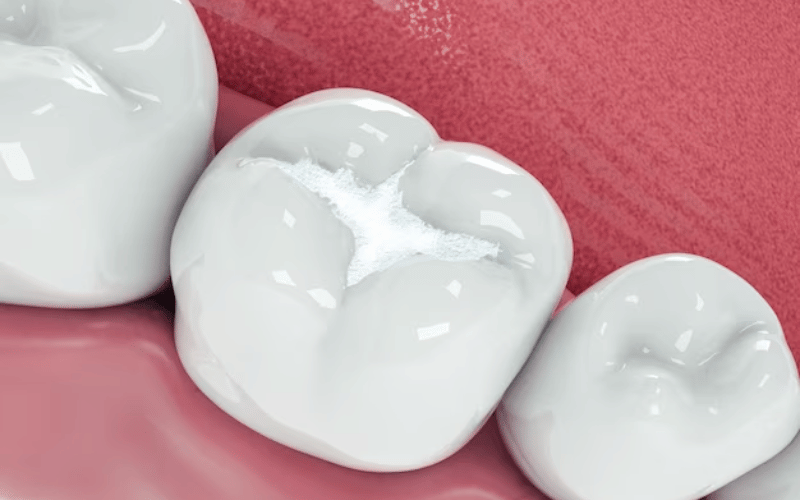White or composite fillings are dental restorations that repair teeth affected by decay or damage. Unlike traditional silver amalgam fillings, white fillings are made of a tooth-colored resin material that blends seamlessly with natural teeth, offering a more aesthetically pleasing option.
They are bonded directly to the tooth surface, providing strength and durability. These fillings require less removal of healthy tooth structure than amalgam ones and can be used for small to moderate cavities in front and back teeth.
Many patients prefer them for their natural appearance and conservative approach to dental treatment.
Benefits
1. Aesthetic appeal: White fillings match the natural color of teeth, providing a more discreet option than silver amalgam fillings, which can be noticeable when smiling or talking.
2. Conservative approach: These fillings require less removal of healthy tooth structure than amalgam fillings, helping preserve more of the natural tooth.
3. Versatility: White fillings can be used for cavities in both front and back teeth, offering a versatile solution for restoring teeth affected by decay or damage.
4. Bonding strength: Composite resin used in the fillings bonds directly to the tooth surface, providing solid and durable restoration that helps to support the remaining tooth structure.
5. Reduced sensitivity: White fillings typically cause less post-treatment sensitivity than silver amalgam fillings, making them more comfortable for many patients.
The Process of Getting a White Filling
1. Examination: The dentist examines the tooth and takes X-rays to assess the extent of decay or damage and determine if a white filling is the appropriate treatment option.
2. Local anesthesia: If necessary, the dentist administers a local anesthetic to numb the area around the affected tooth, ensuring a comfortable experience during the procedure.
3. Tooth preparation: The dentist removes the decayed or damaged portion of the tooth using a dental drill, creating a clean surface for the filling. Unlike silver amalgam fillings, white fillings require minimal removal of healthy tooth structure.
4. Composite placement: The dentist applies layers of tooth-colored composite resin material to the prepared tooth, shaping and sculpting it to match the natural contours of the tooth.
5. Curing and finishing: A special light hardens the composite material, bonding it securely to the tooth. Once cured, the filling is polished to smooth rough edges and ensure a natural-looking result. The patient can resume normal activities immediately after the procedure, as there’s typically no downtime associated with getting a white filling.
Comparison with Traditional Silver Amalgam Fillings
1. Aesthetic appearance: White fillings blend seamlessly with natural teeth, providing a more aesthetically pleasing result compared to the conspicuous appearance of silver amalgam ones, which are noticeable when smiling or talking.
2. Tooth conservation: White fillings require less removal of healthy tooth structure during the preparation process than silver amalgam fillings, which often necessitate more aggressive tooth preparation.
3. Bonding strength: White fillings bond directly to the tooth surface, providing a solid and durable restoration that can help support the remaining tooth structure. Silver amalgam fillings, on the other hand, rely on mechanical retention and may weaken the tooth over time.
4. Sensitivity: White fillings typically cause less post-treatment sensitivity than silver amalgam fillings, sometimes leading to temperature sensitivity due to their high thermal conductivity.
5. Mercury content: While silver amalgam fillings contain mercury, white fillings are mercury-free, offering a more biocompatible option for patients concerned about potential mercury exposure.
Cost and Insurance Coverage
1. Cost: White fillings generally tend to be more expensive than silver amalgam due to the higher cost of materials and the technique-sensitive nature of the procedure. The cost can vary depending on factors such as the size and location of the filling and the dentist’s location.
2. Insurance coverage: Many dental insurance plans cover the cost, but coverage levels may vary depending on the specific plan and the filling chosen. Some plans may cover white fillings at the same rate as silver amalgam fillings, while others may require patients to pay the price difference out of pocket.
3. Out-of-pocket expenses: Patients may need to pay the price difference between white fillings and silver amalgam fillings if their insurance plan does not fully cover the cost of the white filling. It’s essential to check with the insurance provider or dentist’s office to understand the coverage details and potential out-of-pocket expenses beforehand.
4. Long-term savings: Despite the initial higher cost, white fillings may offer long-term savings due to their durability and aesthetic appeal. They may require less frequent replacement than silver amalgam fillings, which can corrode or weaken over time, potentially reducing the need for future dental procedures and associated costs.
5. Financing options: Some dental offices offer financing options or payment plans to help patients manage the cost of white fillings. Patients can inquire about these options with their dentist’s office to explore affordable payment solutions.
In conclusion, white fillings offer a superior choice for dental restoration, providing aesthetic appeal, tooth conservation, and biocompatibility. DNA Dental Studio Burbank specializes in delivering high-quality white fillings in Burbank, ensuring a natural and durable solution for our patients.
Say goodbye to conspicuous silver fillings and hello to a brighter, healthier smile. Experience the difference with DNA Dental Studio Burbank and discover the benefits of modern dentistry. Schedule your appointment today, and let us transform your smile with our premium fillings restoration treatment.

